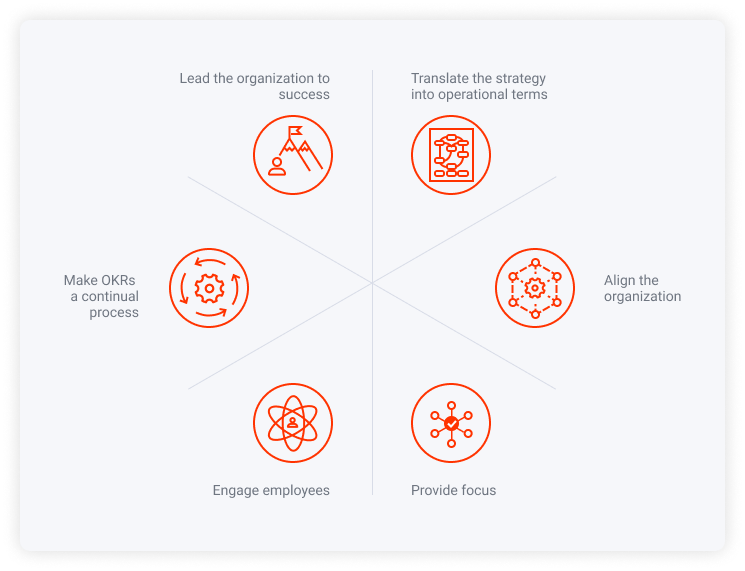Brett Knowles, pm2 Consulting
Brett is a long-time thought leader in the Strategy Execution space for high-tech organizations, beginning in the late 80’s while teaching at Harvard and being involved in the initial Balanced Scorecard research and books. His client work has been published in Harvard Business Review, Forbes, Fortune and countless other business publications.
Pub: April 15 2021
Upd: November 14 2022
OKRs continue to be a hot topic, now more than ever given the current climate of remote work. Organizations continue to look for the best way to use OKRs to improve their employees’ performance and execute their strategies successfully.
Adopting the objective and key results (OKRs) methodology allows for better alignment throughout your business, faster growth, employee engagement and transparency.
In this article, we introduce you to our proposed broader model for how to assess the capability/readiness of your organization's OKR approach. We are aware that there are a number of "OKR Maturity" models out there - but they seem to limit themselves by what the author's software does, or their consulting offerings.
The model proposed below is based on our research at Harvard* and many decades of organizational experience. This OKR model, like others, is not a ‘one-size-fits-all’, but it may be a better starting point for your organization.

 Translate the Strategy into Operational Terms
Translate the Strategy into Operational Terms
To achieve breakthrough results, you must translate your strategy into a language that everyone understands (otherwise, how can they execute it for you?). The long-term strategy must be broken down to clear objectives for this year, this quarter, and even this month, in ways that describe the scope, functions, and activities that people can relate to.
The sort of things that we look for here include: is there a defined goal management framework, are the outcomes defined through S.M.A.R.T. metrics, and are they wide and deep –i.e. no blind spots?
 Align the Organization
Align the Organization
Align the Organization through OKRs – The team defines what needs to be done, by whom, and when. In an OKR-aligned organization, work units become linked to the organization’s strategy through common objectives and key results, thus creating a synergy that ensures that the linkages continue to work.
What we look for here includes: is there a solid vertical and horizontal integration of goals, a direct line of sight between goals and what they support, do they show the cross-functional nature of work, and is there clear visibility of OKRs and alignment up & down and across the organization?
 Provide Focus
Provide Focus
Organizational success requires focus. Focus on the core activities that lead to success – and release the activities that consume time and energy with little return. Everyone understands their purpose - how they impact the objectives and key results of the organization, how that enables strategy success, and how that connects to the higher purpose of the organization.
Focus is indicated by such things as: do teams set their own goals based on the north star, are goals set autonomously, and what is the level of self-management?
 Make OKRs a Continual Process
Make OKRs a Continual Process
The cadence of business is no longer annual – in fact, COVID has proven that even a quarterly cadence may not be frequent enough to match the system changes in your business. OKRs provide the mechanism to make strategy a continual process. Effective organizations must have continual performance reporting, frequent performance conversations to process the learning and re-align their objectives and key results. Agile organizations are created through the continual alignment enabled by OKRs.
Here we expect to see such things as: is there continuous testing of hypotheses and perpetual evolvement of goals, is there a smooth refresh process, is there enabling technology that enables transparency and ease of use?
 Lead the Organization to Success
Lead the Organization to Success
OKRs are the fuel that powers performance, but leadership drives the organization. Effective leadership, as seen through effective meetings, decisions consistent with the OKRs, timely support, and agility, deliver performance gains. OKRs allow leaders to do their job in ensuring we are all pulling in the right direction, and rapid feedback on the choices leaders make. And we are all leaders.
Indicators of strong leadership include: leadership walks the talk, there is meeting maturity and psychological safety, and, ironically, is there a reduced need for strong leaders?
 Engage Employees
Engage Employees
Employee engagement comes through five intrinsic rewards, all of which are delivered through OKRs: purpose, mastery, progress, autonomy, and socialization. OKRs allow every employee to understand how they connect with the organization’s strategy and higher purpose. OKRs track your ability to master the skills required to achieve your purpose and see the ongoing progress that you are making towards those goals. OKRs support autonomy as they allow you to achieve your outcome-based objective in the way that suits your capabilities best and the transparency of OKRs allows meaningful conversations about performance.
Our checks in this area cover things like: is their clear goal accountability (RACI, RAPID, etc.), are results reporting risk-free, honest, and is confidence self-reported?
So there you have it - the framework for a broader OKR Maturity model. We’ve learned to see OKRs as the perfect system of strategy execution, hence the most important system in your organization!
Using a performance management tool like Hirebook helps remote teams link their day-to-day actions to strategic organizational outcomes. Try Hirebook for free today to utilize check-ins, 1-on-1s, OKRs, and KPIs to help your team achieve the next level of success.
NOTE: The work from Harvard referred to here was ultimately published as "The Strategy Focused Organization" by Dr's Kaplan and Norton. The work identified five elements which have been adapted and added to here.
Photo credit - bedneyimages
- Relevant
- Recent
- Topics
- Archive
- April 2023 (1)
- March 2023 (1)
- June 2022 (1)
- May 2022 (3)
- April 2022 (3)
- March 2022 (5)
- February 2022 (2)
- January 2022 (3)
- December 2021 (3)
- November 2021 (4)
- October 2021 (5)
- September 2021 (8)
- August 2021 (7)
- July 2021 (2)
- June 2021 (3)
- May 2021 (5)
- April 2021 (8)
- March 2021 (4)
- February 2021 (3)
- January 2021 (3)
- December 2020 (6)
- November 2020 (9)
- October 2020 (1)
- September 2020 (5)
- August 2020 (4)
- July 2020 (1)
Discover More Hirebook Posts










